
Top 6 Digital Safety Tools for Modern Parents
Keeping kids safe online is harder than ever. With 95% of teens owning smartphones and nearly half being online constantly, parents face growing digital threats like cyberbullying, sextortion, and deepfake misuse. Tools powered by AI can help bridge the gap and protect children effectively. Here are six top-rated digital safety tools:
- Guardii: AI-driven monitoring for direct messages and cross-platform protection.
- Bark: Contextual AI scans texts, social media, and more for risks like bullying and self-harm.
- Qustodio: Flexible parental controls with screen time limits and web filtering.
- Life360: Combines location tracking with driving reports and identity theft protection.
- Amazon Alexa Guard for Kids: Smart voice controls for digital and physical safety.
- AI Parental Control Chrome Extension: Real-time browser content filtering using AI.
Quick Comparison
| Tool | Monthly Price | Best For | Key Platforms | Detection Features | Privacy Approach | Trial Period |
|---|---|---|---|---|---|---|
| Guardii | Not specified | Direct message safety | Cross-platform | Context-aware threat detection | Local processing | Available |
| Bark | $5.00 | Overall monitoring | iOS, Android, Web | Social media, image, and video scanning | Cloud-based analysis | 7 days |
| Qustodio | Free / ~$4.58 | Budget-conscious | iOS, Android, Windows, Mac | AI alerts, web filtering | Cloud dashboard | Free / 3 days |
| Life360 | $2.99 | Location tracking | iOS, Android | GPS tracking, driving reports | Location-focused data | 7 days |
| Amazon Alexa Guard for Kids | Included w/ Alexa Plus | Voice interaction safety | Alexa devices | Voice command filtering | Amazon ecosystem | 30 days |
| AI Parental Control Chrome Extension | Free demo / Paid tiers | Browser protection | Chrome-compatible devices | Real-time content categorization | Local processing | 25 daily analyses free |
These tools help parents address online risks while respecting privacy. Pair technology with open communication to empower your kids to navigate the digital world safely.
7 Best Parental Control Apps: iPhone & Android (Free & Paid)
1. Guardii
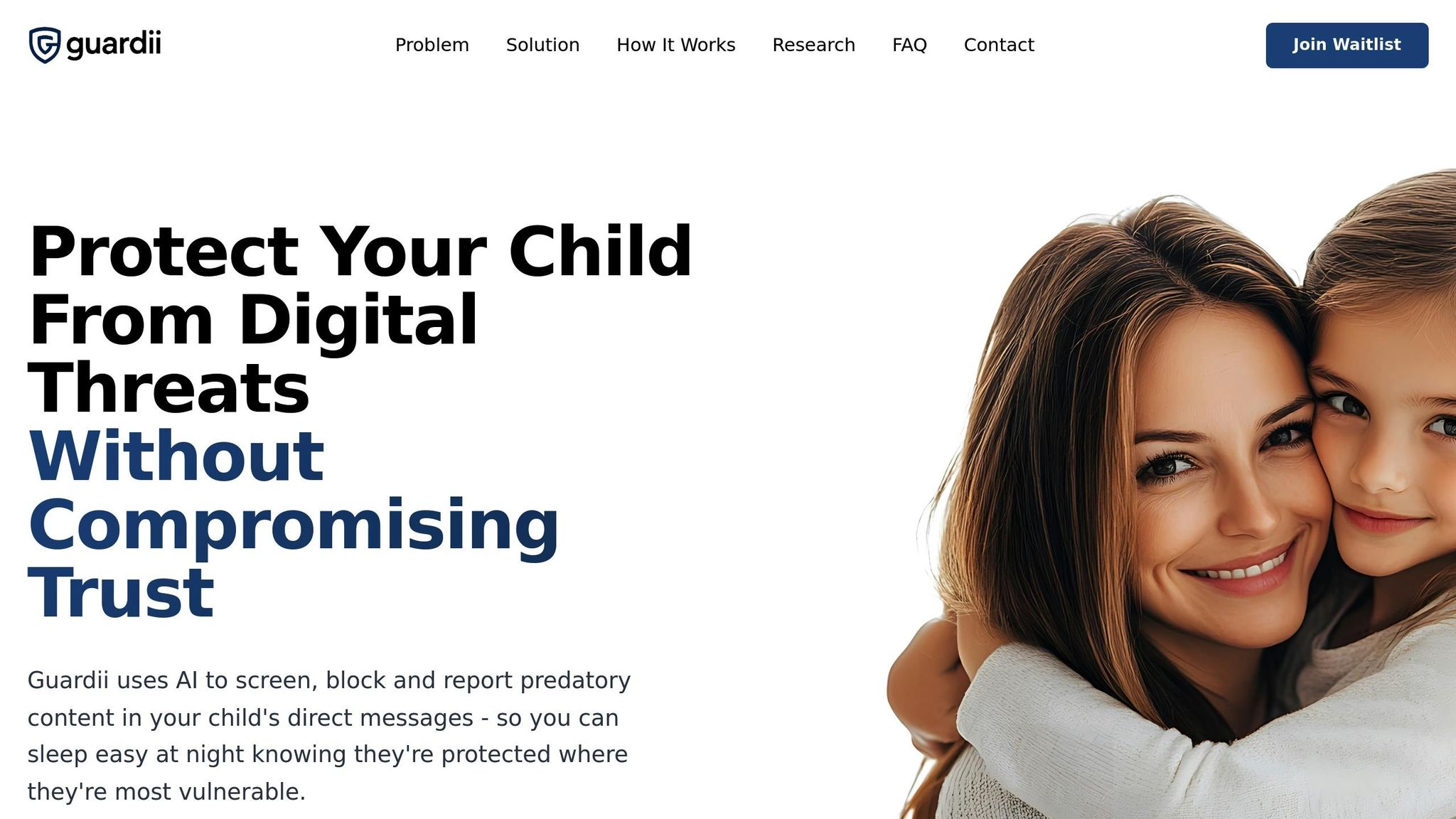
Guardii is an AI-powered safety tool designed to protect children in the digital world. Unlike older monitoring tools that rely on simple keyword filtering, Guardii takes a smarter approach, using advanced artificial intelligence to monitor direct messages and online interactions in real-time. Its standout features include AI-based threat detection, compatibility across multiple platforms, privacy-conscious design, and customizable parental controls.
AI-driven threat detection
At the heart of Guardii is its advanced AI system, which constantly scans messages, comments, and posts to identify offensive language, hate speech, and potential threats. What sets it apart is its ability to analyze context and conversation patterns, making it effective at spotting risks like cyberbullying as they happen. This proactive approach is critical, especially considering that nearly two-thirds of children report encountering online harms such as cyberbullying or inappropriate content.
Cross-platform compatibility
In today’s multi-device households, ensuring consistent protection across all devices is essential. Guardii is designed to work seamlessly on smartphones, tablets, and computers. This means children remain protected regardless of whether they’re using a phone for social media, a tablet for gaming, or a computer for schoolwork.
Privacy-conscious design
Guardii strikes a balance between safety and privacy. Its context-aware AI minimizes false alarms by focusing on genuine threats, avoiding unnecessary intrusions. For situations requiring further action, Guardii includes secure evidence preservation features, which allow critical information to be safely stored for potential use by law enforcement. This approach ensures children’s safety without overstepping privacy boundaries.
Customizable parental controls
Guardii doesn’t just monitor - it empowers parents with tools to manage their child’s online experience. For instance, its web filtering feature allows parents to block or permit specific categories and URLs. App management tools let parents control access to certain apps, set daily usage limits for social media or gaming, and even block specific applications entirely.
Parents can also manage their child’s contacts by restricting phone calls and text messages to approved numbers or outright blocking unwanted contacts. Screen time controls provide additional flexibility, letting parents set limits for individual apps or overall device usage, promoting a balanced digital lifestyle. As children grow, these settings can be adjusted to suit their changing needs. Whether parents choose to block harmful apps and websites entirely or simply monitor their use, Guardii provides the tools to adapt to each family’s unique requirements.
2. Bark
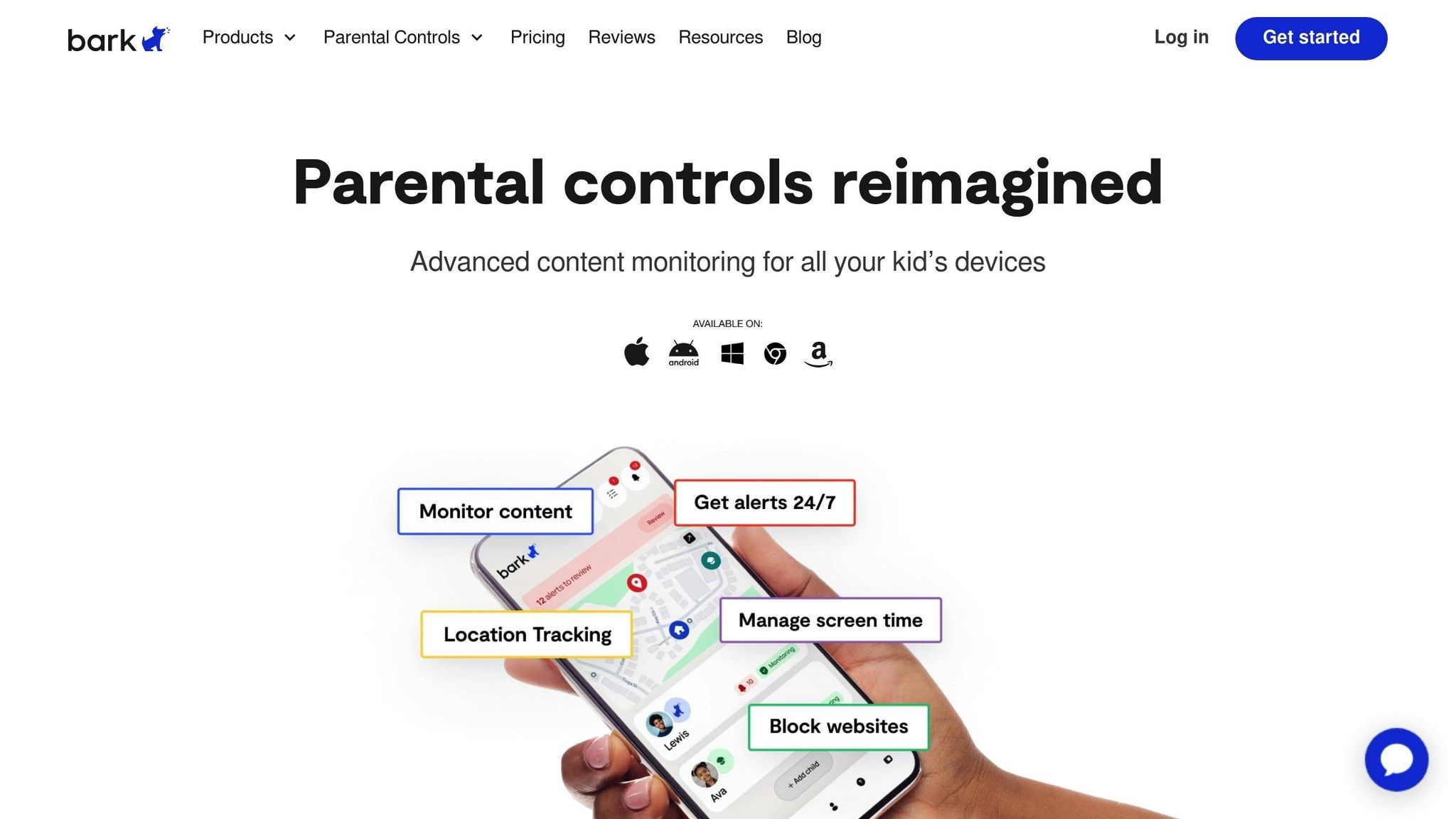
Bark is a digital safety tool that uses advanced machine learning to help protect children across a variety of online platforms. Unlike older systems that rely on simple keyword filters, Bark’s AI dives deeper, analyzing context and patterns to detect real threats while reducing unnecessary alerts. Its ability to provide detailed threat analysis alongside multi-device support makes it a standout choice for families prioritizing online safety.
AI-driven threat detection
Bark’s AI keeps an eye on texts, social media activity, images, videos, and even audio for risks like cyberbullying, explicit content, and other dangers. It evaluates content across 29 different risk categories, giving parents a clear understanding of their child's digital world.
The numbers speak volumes: Bark has safeguarded 7.5 million children, detecting 3.9 million instances of severe self-harm risks and 6.3 million severe bullying cases. These results highlight the platform’s ability to identify and address critical safety concerns that might otherwise slip under the radar.
Currently, Bark’s AI supports English, Spanish, and Afrikaans, making it accessible to families across the United States and beyond.
Cross-platform compatibility
Bark is designed to work across a wide range of devices, including iPhones, iPads, Android phones and tablets, Windows PCs, Macs, Chromebooks, and Amazon Fire tablets. This broad compatibility ensures that no matter what device your child uses, Bark provides consistent protection.
For families seeking additional layers of security, Bark offers hardware options like the Bark Phone, Bark Watch, and Bark Home. These devices provide enhanced monitoring and network-level protection.
It’s worth noting that iOS users need either the Bark Desktop App or Bark Home for full monitoring capabilities. If a child’s device isn’t fully compatible, parents can still monitor email and social media accounts through Bark Premium.
Privacy preservation
One of Bark’s core strengths is its balanced approach to monitoring. It aims to keep kids safe while respecting family privacy. Instead of constant surveillance, the platform focuses on notifying parents about potential risks.
Parents often praise this thoughtful approach. Heather W., a long-time user, shared:
"Using Bark for over 5 years, it has kept me informed about issues I need to address with my kids."
Another parent, Lori E., appreciated how Bark manages safety without overstepping:
"Great service that monitors and addresses kids directly, promoting safety without invading privacy."
This privacy-conscious strategy builds on the protective groundwork established by earlier tools like Guardii.
Parental control customization
Bark allows parents to tailor the platform to meet their family’s unique needs. For instance, parents can adjust alert sensitivity to focus on serious risks, such as drug-related content, while ignoring minor issues.
The system also lets parents create custom app schedules, block specific websites, and filter content based on their child’s age. This flexibility ensures that Bark’s safety measures grow and adapt as children get older.
Thanks to its effectiveness, Bark has earned high praise from safety experts, including being named the best overall parental control app in SafeWise’s Kids Safety Awards.
3. Qustodio
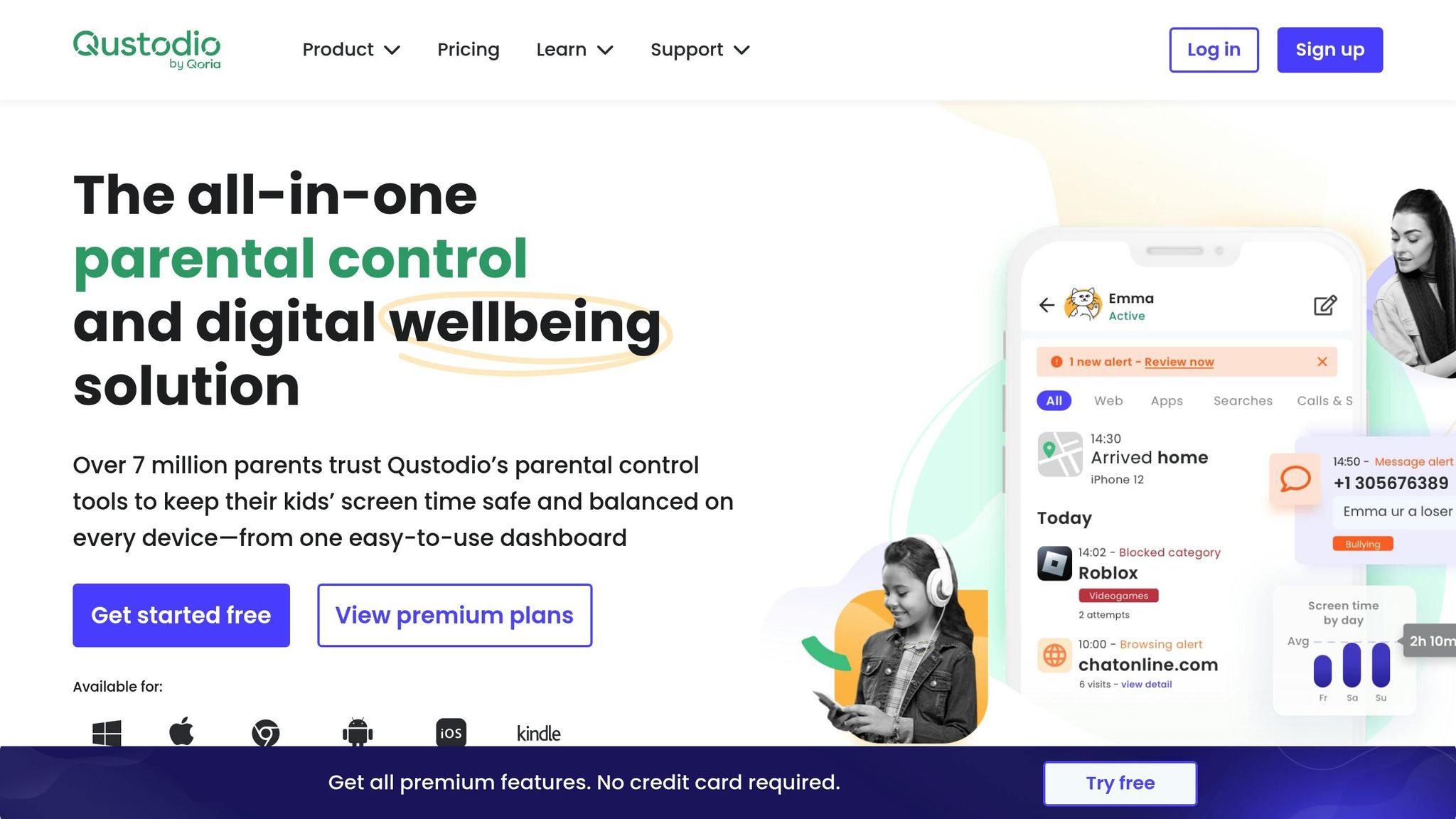
Qustodio combines parental controls with tools designed to promote digital wellbeing, adjusting its safety features as children’s online behaviors change. By integrating advanced AI with customizable options, it caters to the evolving needs of today’s families.
AI-driven threat detection
With its AI-powered system, Qustodio identifies potential risks like inappropriate content and online harassment. It alerts parents before situations get out of hand while avoiding excessive notifications that could become overwhelming.
Cross-platform compatibility
Qustodio works seamlessly across multiple platforms, including Android, iOS, Windows, Mac, Chromebook, and Kindle. This ensures families can maintain consistent safety measures no matter the device. For iOS users, monitoring calls and SMS requires access to a Windows or Mac computer. Premium plans also offer unlimited device coverage for added convenience.
Parental control customization
Parents can fine-tune Qustodio’s settings to match each child’s needs. Features include web filtering, setting daily screen time limits (with options for bedtime or study restrictions), and monitoring activities like browsing, YouTube, social media, and location. Weekly email updates, psychologist-endorsed conversation prompts, and a digital agreement encourage open discussions about online habits. For added safety, the Android Panic Button allows children to send an SOS alert if needed.
4. Life360
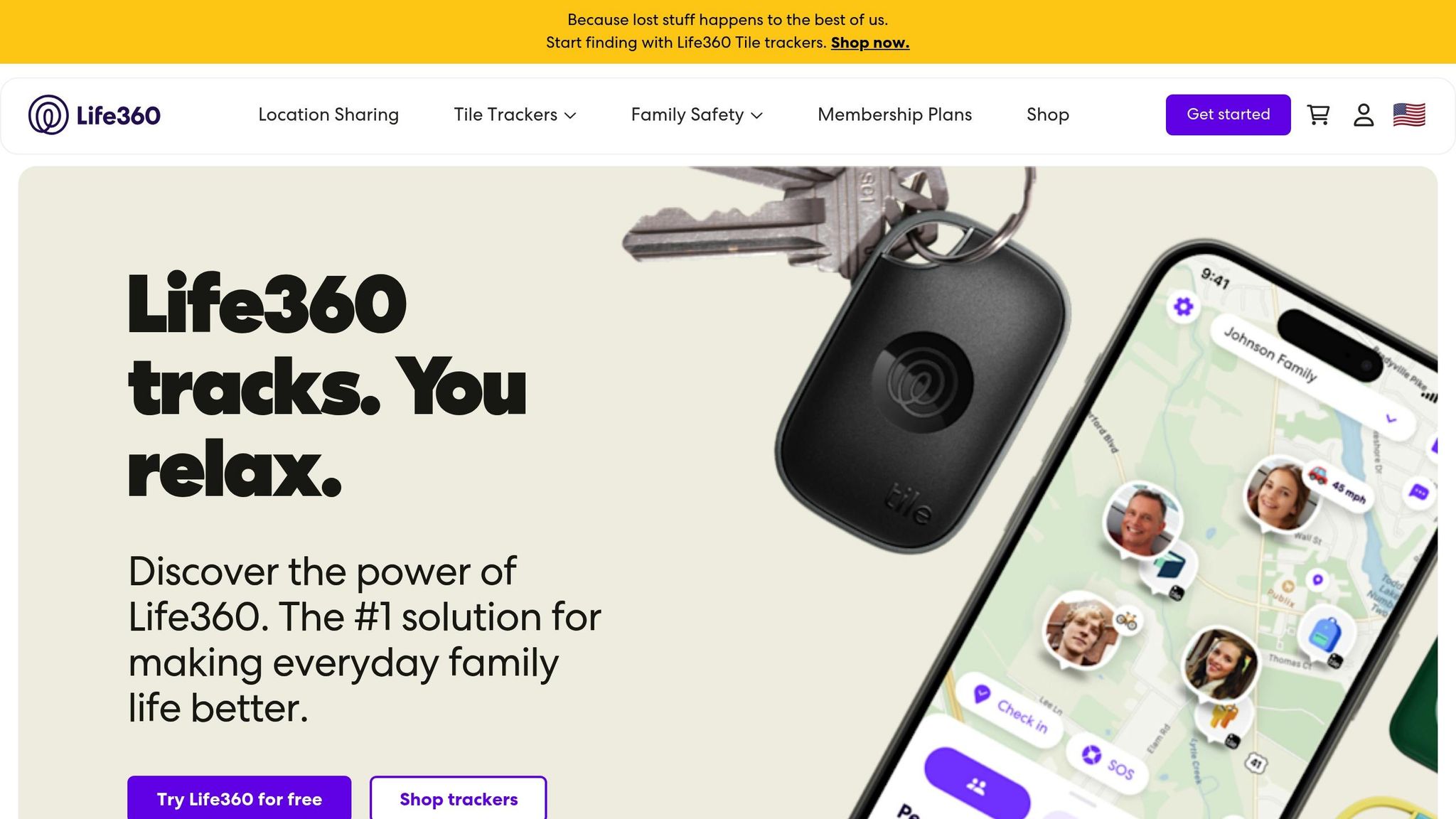
Life360 blends physical safety with digital security, offering much more than just location tracking. With around 79.6 million monthly active users across over 170 countries as of December 31, 2024, this app has grown into a full-fledged family safety platform designed for today's connected families.
Works Across Devices
Life360 is compatible with both iOS and Android, making it a great fit for families using different devices. The app uses standard protocols to ensure location sharing and alerts work smoothly, no matter the operating system. This way, parents can stay connected with their loved ones regardless of their device preferences.
Balancing Privacy and Safety
Life360 takes privacy seriously by using consent-based tracking and customizable sharing options. For example, users must download the app, create an account, grant location access, and accept Circle invitations before sharing their location. It also features "Bubbles", which allows children to share approximate locations instead of exact ones, providing a middle ground between safety and privacy. Parents can further manage Circle permissions, such as controlling who can create new groups, and they can opt out of data sharing with advertisers through the "Your Privacy Choices" setting.
Flexible Parental Controls
The app gives parents tools like geo-fencing, which sends alerts when family members arrive at or leave specific locations. For parents of teen drivers, detailed driving reports track information like trip duration, top speed, and routes taken. One parent, Kathleen C., highlighted how geo-fencing and crash alerts offered her peace of mind for both her teenage driver and younger child.
Beyond location tracking, Life360 has expanded its offerings to include identity theft protection, credit monitoring, and alerts for data breaches. These added features make it a well-rounded digital safety solution. Premium plans start at about $4.99 per month, and the app holds an impressive 4.7 out of 5 rating on Capterra.
5. Amazon Alexa Guard for Kids
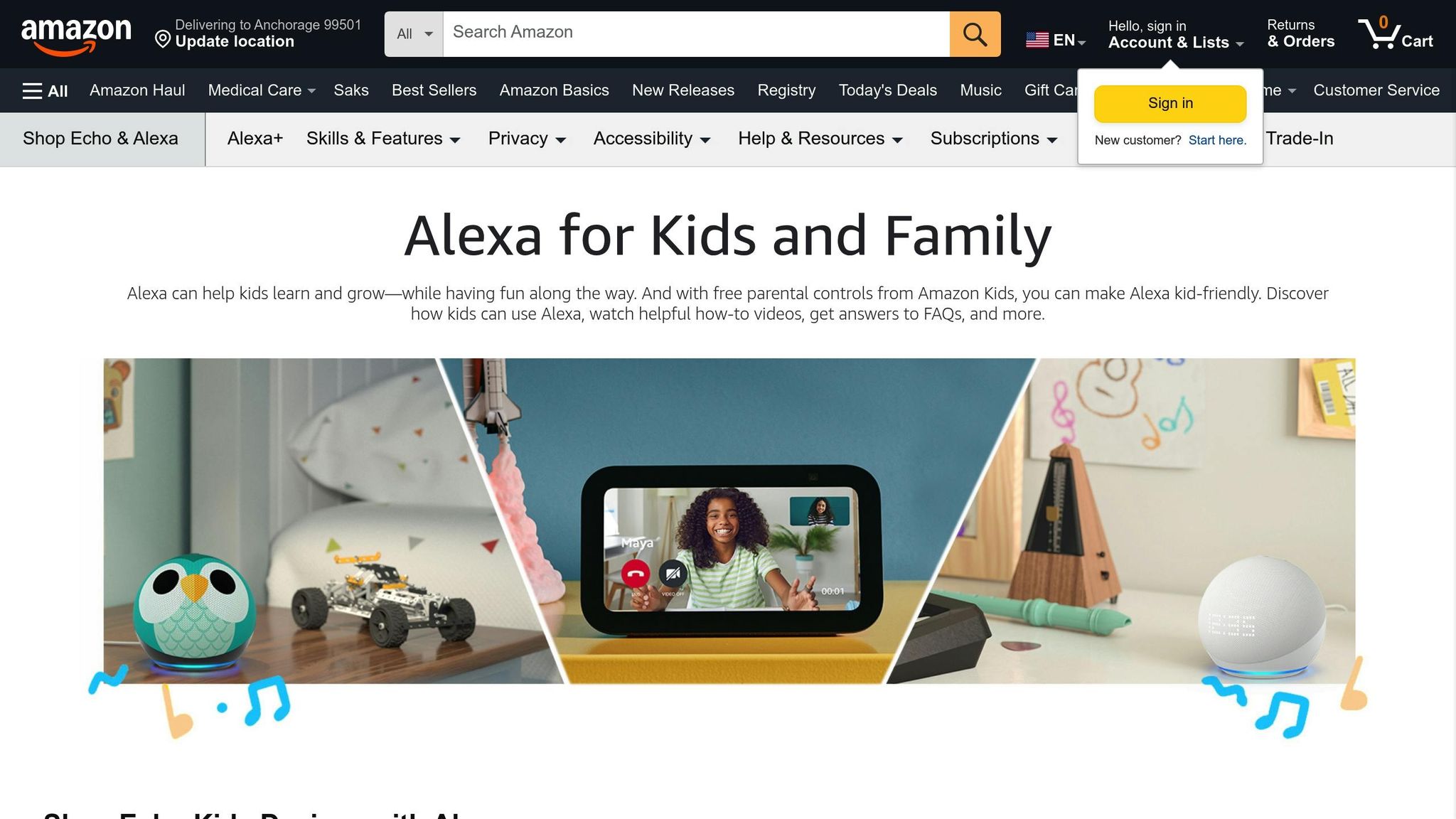
Amazon Alexa Guard for Kids takes digital safety to the next level by turning Echo devices into multifunctional safety hubs. Designed specifically for children in the U.S., this tool combines voice-activated controls with smart systems that address both digital and physical safety concerns. It’s more than just parental controls - it’s a comprehensive system powered by AI to create a safer environment for kids.
AI-Powered Safety Features
Alexa’s AI ensures that kids only access age-appropriate content. Advanced filters block adult websites, while searches and conversations are monitored to keep inappropriate material out of reach. With Voice ID, Alexa recognizes when a child is speaking and adjusts its responses to be more suitable for younger users.
On the physical safety side, Alexa Guard has proven its ability to detect potential hazards. For example, in 2019, CNET demonstrated how the system could identify the sound of breaking glass or a smoke alarm. In both cases, the Echo device promptly sent alerts to a connected phone, showcasing its ability to respond to real-world threats. This level of monitoring works seamlessly across various devices.
Compatibility Across Devices and Platforms
Alexa Guard works with a wide range of Echo devices, including Echo, Echo Dot, Echo Plus, Echo Show, Echo Spot, and Echo Input. It also integrates with home security systems like ADT and Ring Alarm. If you subscribe to the Ring Protect Plus plan, Alexa Guard Plus is included at no extra cost. Additionally, the system can control compatible smart lighting to make it look like someone is home when you're away.
Privacy and Control
Amazon prioritizes family privacy with consent-based monitoring and customizable sharing options. Parents maintain full control over the information collected and can set up individual child profiles to ensure interactions remain age-appropriate. Amazon is clear about the system’s limitations, stating, “Alexa Guard is not a replacement for an alarm system or life safety devices. Amazon does not monitor Smart Alerts and cannot contact emergency services on your behalf”.
Customizable Parental Controls
Parents can create up to four child profiles per household, each with its own age filters and preferences. The Parent Dashboard offers tools to manage content, set screen time limits, and monitor activity. Features like Bedtime limits allow for different rules on weekdays and weekends. The Educational Goals feature encourages kids to focus on learning by restricting non-educational content until specific goals are achieved. Parents can also pause a child’s Echo device for up to 12 hours through the dashboard. The system’s age filters are highly adjustable, catering to children as young as 2 and up to 13 years old. Additionally, kids can only call or message approved contacts on Amazon Kids-enabled Echo devices.
sbb-itb-47c24b3
6. AI Parental Control Chrome Extension

The AI Parental Control Chrome Extension brings advanced AI capabilities directly into your browser, offering a safeguard against harmful online content for your child. Powered by OpenAI's ChatGPT technology, it analyzes and blocks inappropriate material in real time, filtering out explicit content, violence, and hate speech. The system is designed to keep up with evolving online threats.
AI-Driven Threat Detection
This extension uses intelligent algorithms to monitor your child's online activity, analyzing usage patterns and interactions to identify and block harmful content. It can detect cyberbullying and recognize potential risks as they happen. Similar systems have shown an impressive 99.8% accuracy in categorizing inappropriate material. Over time, the extension learns individual behavior patterns and sends real-time alerts for risky activity, giving parents the chance to step in when needed.
Cross-Platform Compatibility
The extension works effortlessly across all devices where Chrome is installed, including Windows PCs, Macs, Chromebooks, and Android devices. Its integration with Chrome's security features ensures consistent protection, whether your child is using a school laptop, a home computer, or a mobile device.
Privacy Preservation
Privacy is a top priority. Using edge computing, the extension processes data locally on your device instead of sending it to the cloud. This ensures your child's browsing data remains private and secure. Built with privacy-by-design principles, it anonymizes and protects personal information.
"The technology acts like a vigilant digital guardian. It can detect subtle signs of harassment that humans might miss, while respecting privacy boundaries." - Dr. Maria Chen, cybersecurity expert specializing in child safety
Balancing safety with fostering independence is key. Transparent communication about digital safety can help your child gain autonomy over time.
Parental Control Customization
The extension offers customizable settings to tailor your child's online experience. You can adjust filters based on age, content type, and activity levels. Password protection ensures settings remain secure, preventing children from bypassing controls.
"Tailor the extension to block specific content categories based on your family's needs." - AI Parental Control
Flexible pricing plans are available, including a free demo option with a daily limit of 25 page analyses. Upgraded plans unlock additional features and higher analysis limits. Beyond just blocking content, the extension provides insights into browsing habits, encouraging meaningful conversations about responsible online behavior while supporting, not replacing, parental guidance. This extension is a valuable addition to any digital safety toolkit.
Tool Comparison Chart
When it comes to choosing the right digital safety tool for your family, the stakes are high. Over 70% of kids aged 8–12 are online daily, yet fewer than 15% understand basic online safety practices. To help you navigate the options, here’s a side-by-side comparison of some popular tools:
| Tool | Monthly Price | Best For | Key Platforms | Detection Features | Privacy Approach | Trial Period |
|---|---|---|---|---|---|---|
| Guardii | Not specified | AI-driven DM protection | Cross-platform messaging | Real-time threat detection, context-aware filtering | Local processing, privacy-by-design | Available |
| Bark | $5.00 | Overall monitoring | iOS, Android, Web | Image scanning, social media monitoring | Comprehensive content analysis | 7 days |
| Qustodio | Free / ~$4.58 | Budget-conscious families | iOS, Android, Windows, Mac | AI-powered alerts, web filtering | Cloud-based dashboard | Forever free / 3-day premium |
| Life360 | $2.99 | Location tracking | iOS, Android | GPS monitoring, driving reports | Location-focused data collection | 7 days |
| Amazon Alexa Guard for Kids | Included with Alexa Plus | Voice interaction safety | Alexa devices | Voice command filtering | Amazon ecosystem integration | 30 days |
| AI Parental Control Chrome Extension | Free demo / Paid tiers | Browser protection | Chrome-compatible devices | Advanced content categorization | Edge computing, local processing | 25 daily analyses free |
Key Considerations
Detection Features
Each tool offers unique strengths in detection. For example, the AI Parental Control Chrome Extension excels in real-time content categorization, while Bark is known for quickly flagging risky behaviors. Guardii focuses on threats in direct messaging, using context-aware analysis to identify potential issues.
Platform Compatibility
Not all tools work seamlessly across devices. Due to Apple’s restrictions on call and text monitoring, no single tool can offer complete protection across all platforms. However, tools like Qustodio and Bark cover a wide range of operating systems, making them versatile choices for families with mixed devices.
Privacy Approaches
Privacy policies vary widely. Tools like Guardii and the AI Parental Control Chrome Extension prioritize local processing, keeping sensitive data on your device. On the other hand, Bark and Qustodio rely on cloud-based systems, offering more comprehensive monitoring but requiring data to be stored on third-party servers.
Budget-Friendliness
Affordability is a key factor for many families. Qustodio stands out with a free version that provides basic protection, making it a good choice for those looking to avoid recurring costs. With digital safety tools ranging from free to premium subscriptions, there’s an option for every budget.
Why Social Media Monitoring Matters
Online bullying is a growing concern, with nearly 40% of kids aged 10–13 having witnessed or experienced it. This makes tools with strong social media monitoring, like Bark, particularly valuable for families with children in this age group. As online interactions increase, investing in tools that address these risks can make a meaningful difference.
Use this chart and these insights to weigh your options and choose the tool that best suits your family’s needs. Whether your focus is privacy, platform compatibility, or budget, there’s a solution designed to help keep your kids safe online.
Final Thoughts
The digital world kids navigate today is vastly different from what their parents grew up with. A striking 70% of adolescents use AI tools, yet only 37% of parents are aware of this reality. This disconnect between what children experience online and what their parents understand highlights the need for more than just tools - it calls for engaged and informed parenting to bridge the gap.
While technology can help, it’s not a standalone solution. As Dr. Scott Kollins, chief medical officer at Aura, explains:
"Kids need more than just limits; they need guidance. Their phones are integral to their social lives and experiences, so simply keeping them off devices isn't an option. Our job as parents is to help them develop healthier tech habits."
This insight underscores the essence of modern digital parenting: it’s not about shutting kids off from technology but equipping them to use it wisely.
The numbers reveal why this balance is critical. One in five girls and one in thirteen boys globally have faced sexual exploitation or abuse before turning 18, with technology playing a role in nearly all cases. Meanwhile, the number of deepfake images online surged from 14,000 to 145,000 between 2019 and 2021. These aren’t abstract dangers - they’re real threats that AI-powered tools can help address, but only when paired with active parental involvement.
No tool can teach kids to spot manipulation or build critical thinking skills. That’s where communication comes in. Encouragingly, 89% of children say they feel comfortable talking to their parents when something online makes them uneasy. This openness is your most powerful ally in keeping them safe.
To create a safer online environment, combine technology with proactive parenting. Use digital safety tools, but also establish clear rules about screen time and online behavior. Be upfront about what these tools monitor and why. Todd O'Neill from Middle Tennessee State University puts it perfectly:
"Parents need to not be afraid to learn. It's not scary technology, it's just technology. There certainly are dangers, but there's dangers in all of our world that's connected to the internet. The same way you teach your child how to cross the street or not touch the hot stove. It sounds silly, but that's our world right now. We're not going to be able to live without it, and so we might as well learn."
Start by having honest conversations with your kids about online risks. Teach them how to spot scams, identify misinformation, and make smart choices. Consider creating a family media plan that outlines screen time limits, approved apps, and device usage rules. The goal isn’t to control their every move but to empower them to navigate the digital world with confidence and awareness.
As highlighted in our reviews, smart technology is just one piece of the puzzle. It’s most effective when it complements your parenting, not replaces it. Pairing these tools with active involvement and open dialogue gives your child the strongest foundation for staying safe online - today and as they grow into savvy, independent digital users.
FAQs
How can I use Guardii to protect my child's privacy online?
Protecting Your Child's Privacy Online
Keeping your child safe online with tools like Guardii starts with a mix of education and smart settings. Begin by explaining why it's crucial not to share personal details - like their full name, address, or school - with anyone online. Create an environment where they feel comfortable talking to you about anything that feels suspicious or makes them uneasy.
Take advantage of Guardii’s parental control features to set clear boundaries on what content they can access. Regularly check the privacy settings on the apps and platforms they use, and stay updated on how these platforms handle data. By staying involved in their online activities, you can build trust and help them explore the digital world with confidence and security.
How do the digital safety tools in the article differ in their approach to privacy?
The digital safety tools discussed in the article take varied approaches to privacy, each designed to safeguard children while being mindful of user data. Many parental control apps emphasize transparency, ensuring users understand what data is collected and how it’s utilized. These tools often focus on giving parents control over privacy settings, while keeping data collection to a minimum.
On the other hand, AI-powered tools lean toward proactive methods, such as content filtering and activity monitoring, to tackle online risks. These tools are typically built to comply with privacy regulations like the Children's Online Privacy Protection Act (COPPA). They often incorporate practices like anonymizing data and limiting how long information is stored to protect children’s identities. Although both types of tools share the goal of keeping kids safe online, their privacy approaches highlight different priorities and techniques.
How do AI-powered digital safety tools help protect children from online threats like cyberbullying and harmful content?
How AI-Powered Tools Help Keep Kids Safe Online
AI-powered tools are stepping up to help protect kids in the digital world by analyzing patterns in their online interactions - like messages, social media activity, and browsing behavior. These tools use machine learning to pick up on warning signs of cyberbullying, exposure to inappropriate content, or other risks that kids might face online.
When something concerning is flagged, parents get real-time alerts, giving them the chance to act quickly. Beyond just alerts, many of these tools can also block harmful content and keep an eye on communications, creating a more secure online space for kids. By tackling potential risks before they escalate, these tools give parents an extra layer of support in keeping their children safe online.